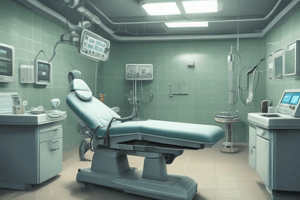Podcast
Questions and Answers
What is the primary purpose of autoclaves in infection control in dentistry?
What is the primary purpose of autoclaves in infection control in dentistry?
- To enhance the color of dental equipment
- To eliminate microorganisms and achieve sterility (correct)
- To provide a comfortable environment for patients
- To reduce the cost of dental procedures
What is the purpose of using antimicrobial barriers in dentistry?
What is the purpose of using antimicrobial barriers in dentistry?
- To prevent oral bacterial colonisation (correct)
- To sterilize instruments
- To enhance patient comfort
- To reduce exposure to bloodborne pathogens
Why is proper training and maintenance of autoclaves essential in dentistry?
Why is proper training and maintenance of autoclaves essential in dentistry?
- To enhance the taste of dental tools
- To ensure the temperature remains consistent during sterilization (correct)
- To improve patient communication
- To reduce waiting times for patients
Which chemical is commonly used in chemical sterilization for instrument disinfection?
Which chemical is commonly used in chemical sterilization for instrument disinfection?
What is a key consideration for effective chemical sterilization without damaging materials?
What is a key consideration for effective chemical sterilization without damaging materials?
Which type of autoclave works by exposing items to high temperatures and pressures within their chambers?
Which type of autoclave works by exposing items to high temperatures and pressures within their chambers?
What is the primary function of barrier protection in dentistry?
What is the primary function of barrier protection in dentistry?
Which sterilization method uses chemicals instead of high heat?
Which sterilization method uses chemicals instead of high heat?
How do barriers help in reducing cross-contamination in dentistry?
How do barriers help in reducing cross-contamination in dentistry?
Which of the following is NOT an example of barrier protection used in dentistry?
Which of the following is NOT an example of barrier protection used in dentistry?
Flashcards are hidden until you start studying
Study Notes
Infection Control in Dentistry
Infection control is a critical aspect of dental care. It helps protect both patients and dental professionals from the transmission of infectious agents during dental procedures. This comprehensive approach involves various measures, including the use of autoclaves, barriers, and chemical sterilization techniques. Here's a brief overview of these essential components:
Autoclave Sterilization
Autoclaves are devices used to heat objects under pressure to eliminate microorganisms and achieve sterility. They are essential tools for infection control in dentistry because they can effectively kill bacteria, viruses, fungi, and spores when properly used. There are two types of autoclaves commonly employed in dentistry: gravity displacement autoclaves and vacuum pressure autoclaves. Both types work by exposing items to high temperatures and pressures within their chambers, which destroys any contaminants present. However, there have been concerns raised about the effectiveness of autoclaves due to temperature fluctuations and operator error, highlighting the need for proper training and maintenance of these machines.
Barrier Protection
Barriers are physical barriers designed to prevent direct contact between patients and healthcare providers, reducing the risk of transmitting disease. Some examples of barrier protection in dentistry include gloves, masks, eyewear, protective clothing, and face shields. These barriers help reduce cross-contamination and exposure to bloodborne pathogens. Additionally, the use of antimicrobial barriers such as antibacterial mouthwashes may also play a role in preventing oral bacterial colonisation associated with specific conditions like endodontic treatments.
Chemical Sterilization Techniques
Chemical sterilization uses chemicals instead of high heat to destroy all forms of life on nonporous surfaces. Commonly used chemical sterilizing solutions include glutaraldehyde, peracetic acid, and hydrogen peroxide. Glutaraldehyde has historically been used for instrument disinfectant followed by dry storage, while newer methods employ vaporized hypochlorite to clean instruments after they are dried. Proper application and dilution of these chemicals are crucial to ensure effective sterilization without damaging materials.
Summary
Effective infection control practices in dentistry involve the integration of multiple strategies, including the use of autoclaves, barrier protection, and chemical sterilization techniques. By following these protocols, dental practitioners can significantly minimize the risks associated with dental procedures and enhance patient safety.
Studying That Suits You
Use AI to generate personalized quizzes and flashcards to suit your learning preferences.




